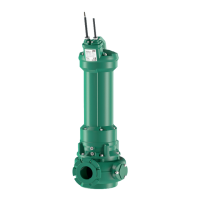en Safety
54 WILO SE 2019-10
site of other protective equipment (e.g. overvoltage, undervoltage or phase failure re-
lay, etc.).
Residual-current device (RCD)
Comply with the regulations of the local energy supply company! The use of a residual-
current device is recommended.
If persons come into contact with the device and conductive fluids, secure the connec-
tion with a residual-current device (RCD).
2.5 Use in fluids hazardous to health
There is a danger of bacterial infection when using the device in fluids hazardous to
health! Thoroughly clean and disinfect the device after dismantling and prior to further
use. The operator must ensure the following:
ƒ The following protective equipment is provided and worn when cleaning the device:
– Closed safety goggles
– Breathing mask
– Protective gloves
ƒ All persons are informed about the fluid, the associated danger and its correct hand-
ling!
2.6 Permanent magnet motor
Permanent magnet motors are driven by a permanently magnetised rotor. Please note
the following when using permanent magnet motors:
ƒ Magnet and magnetic field
There is no risk from magnets and the magnetic field as long as the motor housing is
closed. Persons with a pacemaker are also not at any particular risk. Screw plugs can
be undone for maintenance purposes without hesitation. Do not open the motor
housing! Only customer service staff are permitted to work on an open motor!
ƒ Generator operation
The motor generates an inductive voltage if the rotor is driven without electrical en-
ergy (e.g. when the fluid returns). In this case, the connection cable is live. Once the
pump has been connected, energy is fed back into the connected frequency con-
verter. Implement the following options to prevent destruction of the frequency
converter and motor as a result of overvoltage:
– Feed back input energy into the supply network.
– Dissipate input energy using a brake resistor.
2.7 Transport
ƒ Wear the following protective equipment:
– Safety shoes
– Safety helmet (when using lifting equipment)
ƒ Always hold the handle to transport the device. Never pull the device by the connec-
tion cable!
ƒ Only use legally specified and approved lifting gear.
ƒ Select the lifting gear based on the prevailing conditions (weather, attachment
point, load, etc.).
ƒ Always attach the lifting gear to the attachment points (handle or lifting eye).
ƒ The stability of the lifting equipment must be ensured during operation.
ƒ When using lifting equipment, ensure a second person is present to coordinate the
procedure if required (e.g. if the operator’s field of vision is blocked).
ƒ Persons must not stand underneath suspended loads. Do not move suspended loads
over workplaces where people are present.
2.8 Installing/dismantling
ƒ Wear the following protective equipment:
– Safety shoes
– Safety gloves for protection against cuts
– Safety helmet (when using lifting equipment)
ƒ Locally applicable laws and regulations for work safety and accident prevention must
be complied with.
ƒ Disconnect the device from the mains and secure it against being switched on again
without authorisation.
ƒ All rotating parts must be at a standstill.
ƒ Provide adequate aeration in closed rooms.
ƒ When working in chambers and closed spaces, a second person must be present for
safety reasons.
ƒ Take immediate countermeasures if there is a build-up of toxic or suffocating gases!
ƒ Clean the device thoroughly. Disinfect devices that are used in fluids hazardous to
health!

